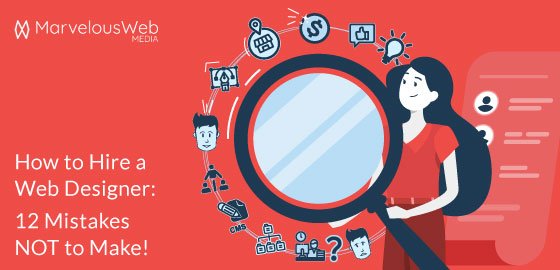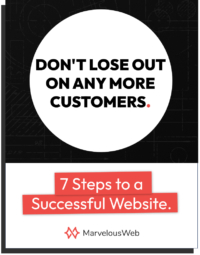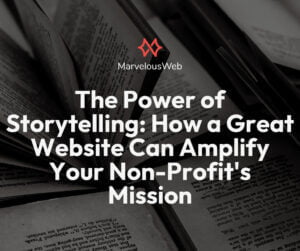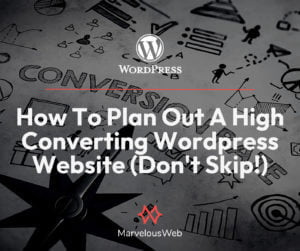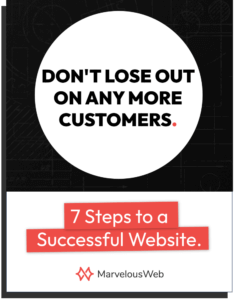Whether you’re starting up an online store or getting your brick and mortar business some online notoriety, a good website is everything in today’s digital age. But before you can show off a great website, you need to figure out how to hire a web designer who can build a website that meets your needs and represents your brand. After all, what is web design without the right web designer.
Web design services aren’t hard to come by. Good web design services are! If you’re not sure what you’re doing, you could end up paying big bucks for a lackluster website—or worse, hiring a web designer who can’t give you what you need. Avoiding these situations means paying close attention to the hiring process and vetting your choice in web designer carefully.
Below are 12 mistakes to avoid when you decide to hire a website designer. Stepping over these pitfalls will help you avoid a lot of headaches, and make sure you end up working with a designer who can deliver the stunning website you need to be successful.
1. Hiring solely based on price
How much should you pay for web design? There’s no good answer to this question. Every website is different and needs a different level of work. A simple restaurant website with a few pages and a hosted menu won’t take nearly as long to set up as an online store with thousands of products!
The real answer to the question of cost is to not hire based on dollar figures. Here’s an example. Say there are two designers vying for your website—one quotes you $200 and one quotes you $600. On the surface, the choice is clear. But the low-cost designer might not give you the same caliber website the higher-priced designer will. Things like clean site code, reliable hosting, wireframe options and more factor into the higher price, and they provide a lot of value that actually saves you money in the long run.
Price is important, but it shouldn’t be the only factor you look at when hiring a designer.
2. Only looking for a local firm
The internet has made the world smaller, and that’s great for finding a professional who can meet your needs. There might only be 3-4 web designers in Lancaster, OH, limiting your hiring options if you need a website created. However, you can just as easily hop online and choose from thousands in nearby Columbus, OH, where more professionals means more opportunities to find the perfect hire.
Don’t feel constrained to looking locally for a website designer. Bakersfield, CA; Billings, MT; Baton Rouge, LA; Boston, MA—it doesn’t matter where they’re located! What matters is their ability to provide you with the website you need, at a competitive price, with the support you need to successfully launch it. Pigeonholing yourself to your local area could mean settling for inferior talent, high prices or inflexible designers.
3. Hiring a ‘graphic’ designer
If you’re not digitally savvy, one of the biggest pitfalls to watch out for is one of nomenclature. A graphic designer isn’t the same thing as a website designer. Sure, a web designer is going to use graphics and layout techniques to make your website pop, but that doesn’t make any old graphic designer a web designer.
Web designers don’t just understand layout and design. What makes them valuable is their experience with coding—specifically HTML and CSS, among other languages like Java and Ruby. These are the building blocks of what people see when they interact with your website. Pretty pictures and vivid colors mean nothing without the coding to coordinate them online. This is why website designers trump graphic designers.
4. “Just make it look good”
Something every website designer absolutely hates hearing is “just make it look good.” This is usually in response to the question, “did you have any design ideas in mind?”
Web designers ask for your input for a reason! Saying “just make it look good” is the equivalent of telling your waiter “just bring me something tasty.” You need to have an opinion. Without any input, a designer has no idea where to start, and the web design process becomes a much more tedious one. You don’t need to know exactly what you want, but you need to provide some answers.
To remedy this, most designers and developers have a quick questionnaire you’ll need to fill out. Be as thorough as possible when answering questions and you’ll find that the website you get is as good (or better!) than the one you want.
5. Working with a middle-man
Today, there’s no shortage of freelance web design platforms out there, built to aggregate candidates and make them easier to browse. The problem is, many of these platforms act as a middle-man—meaning you need to contact the designer you want through the platform. In some cases, this is okay… but it’s important to be wary of the potential for pitfalls.
For example, some platforms may take a cut of the final transaction—either from you or the designer you choose. In other situations, these middle-man platforms make it harder to communicate with the professional you’ve hired. They might even mask the identity of the designer, so you have no real idea of who you’re doing business with.
It’s always best to deal directly with the web designer you’ve hired. Not only does it offer easier communication, it’s also good for long-term partnerships. Remember, your website will need updates and changes in the future! Best to work with someone you can develop a rapport with.
6. Not having examples or ideas
In the same vein as “just make it look good,” one of the worst things to do when hiring a web designer is to start looking before you know what you need or want. The more clear-cut decisions you can make before you start talking with a developer, the smoother the process will go. At a basic level, you should answer a few simple questions:
- What’s the purpose of your website? (lead-gen, branding, information)
- What kind of content do you want on it? (gallery, pricing, service info)
- Do you have any materials? (pictures, logos, existing copy)
- What’s your budget?
- What’s your timeline?
Answers to these questions will provide tons of context for the designer you hire and give them a basic concept to focus on. Even better is to have competitor links or URLs of websites you like, so the designer can use them for inspiration.
7. Not getting a native CMS
CMS stands for “Content Management System,” and it’s something your website absolutely needs. A CMS is where all the images, blog posts and hosted files of your website will live. Having them all in one place, easily accessed and updated, is important for maintaining your website. Every time you want to upload a new image or post a new article, you’ll interact with the CMS. A website without a convenient CMS will make it very hard to do these things.
The problem is, not every website designer gives thought to a native CMS. It’s best to work with a designer who builds on a platform like WordPress or HubSpot, which have powerful CMS’, instead of platforms like Wix or a similar website builder, which don’t. Ask a designer what platform they build on and make sure it offers a native CMS, and avoid choosing a designer who doesn’t know what a CMS is or who designs without a CMS in mind.
8. Not establishing a sitemap
Building a website is about more than putting together good-looking graphics and a few clickable icons. The foundation of a website is the sitemap—a layout of all the pages needed to create an online experience. Before any design work begins, you should have an idea of what you want your sitemap to be. Not only does this frame the scope of your website, it also likely impacts the price and timeline for completion.
Do you need a simple long-scrolling landing page? Half a dozen pages to explain your business? Hundreds of pages for each of your many products? Get a feel for how many pages you think you’ll need, as well as the nature of those pages. A simple contact page might not require a whole lot of design work, where product pages might be better templated, for example.
Establishing your sitemap is going to make finding a website designer easier. They’ll understand your needs better upfront, and you’re likely to attract designers who have experience with similar site sizes and types.
9. Not asking questions
Hiring a designer to build your website is the same fundamental process as hiring a professional for anything else. That is to say, you’re relying on their expertise. Ask questions!
Not asking questions leaves a major gap in expectations. “Do you have experience integrating ecommerce capabilities?” It’s a simple question, but a tremendously important one to ask. If the purpose of your site is to sell things and you hire a web designer without ecommerce experience, you’re likely not going to get the best product. Ask about capabilities, experience, design approach, process and anything else that might impact the final website you expect to get from someone.
Asking questions is a natural part of the process when hiring a web designer, so don’t be afraid to get picky. Someone who knows their stuff won’t have any trouble providing straight answers to your questions.
10. Build in revisions and feedback
When you think you’ve found the right web designer to hire, make sure you take the time to establish a process for revisions and feedback. Building a website isn’t a one-and-done process most times. You need a way to let your designer know what you like and don’t like, what needs changing and what doesn’t work. Design work is subject to change—make sure you have a way to request those changes.
Most designers will approach revisions in one of two ways. Some give a defined revisions period—“I offer free revisions for 14 days, then for $X per hour after 14 days.” Others d it incrementally—“I offer three rounds of free revisions and $X per hour for every subsequent round.” These terms are fairly standard. Make sure you understand them and, if they’re abnormal, get clarification. It’s well-within your right to ask for revisions and provide feedback, but you need to make sure it’s through a mutually agreed-upon process.
11. Not establishing a scope of work
As a business owner, think of hiring a website designer as delegating work. And, just like you’d delegate work to an in-house employee, you need to define the scope of work. You can’t just say “build me a website” and expect your vision to be fulfilled!
Take the time to define the full scope of work of your design project. That means going beyond the actual design process. Focus on things like timeline (when do you want it done?) and support services (social media or email integration). Get a comprehensive quote for a comprehensive plan—it’s the only way to hire a designer with confidence. Remember to put the scope of work in writing and have clear dates and deadlines set, too. It’s the best way to start on the same page, with the same expectations.
12. Avoid bad gut feelings
One of the biggest mistakes people make when hiring web developers is ignoring their gut. They get a bad feeling about something and instead of addressing it, they sweep it under the rug and deal with it later. Unfortunately, this leaves them vulnerable.
Maybe the web designer you’re interviewing is reluctant to show you their portfolio? Their rates seem too good to be true? They’re erratic with their communication and hard to get a hold of? Don’t ignore these red flags! Listen to your gut when it says to proceed with caution and you’ll end up making a good decision about the designer you ultimately choose.
Hiring a web designer isn’t something you do every day. Avoid these 12 mistakes and you’ll do just fine! Remember, the key to finding the right designer is to ask the right questions, take the time to evaluate your needs and maintain a good level of communication. Learning how to hire a web designer is easier than you think!

